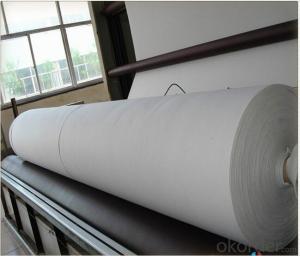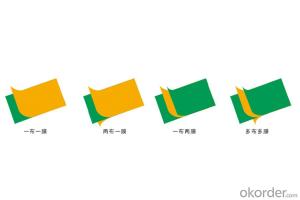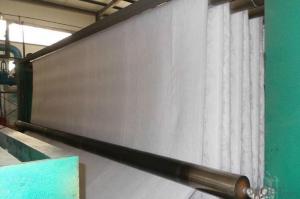Geotextile Non Woven PP Earthwork for Road and Railway
- Loading Port:
- Tianjin
- Payment Terms:
- TT or LC
- Min Order Qty:
- 5000 m²
- Supply Capability:
- 2000000 m²/month
OKorder Service Pledge
OKorder Financial Service
You Might Also Like
Quick Details
Type: GeotextilesPlace of Origin: Hebei, China (Mainland)Brand Name: CMAX GeotextileModel Number: HT3258Geotextile Type: Non-Woven GeotextilesColor: Black , white , greyApplying Area: Road,River bank , lake dam, mine remainings, reservior, tunnelManufacturing method: Nonwoven / wovenWidth: within 8mWeight: 100-1500gsmLength: 50-100m/roll;at requestName: PP Geo Fabric Rolls/ geotxtile used in garbage burying field
Packaging & Delivery
Packaging Details:pallet and design the packing according to client's requestsDelivery Detail:15-30days after received deposit
Landfill Geotextile Polyurea
1. Geotextile Specifications
1) Weight / Mass: 100g/m2-1500g/m2 .
2) Width: Within 8 m (1m-8m as request ).
3) Length: 50m-100m/roll (as request).
4) Material: PP / PET .
5) Certificate: CE/ISO9001/ISO14001
6) Manufacturing method: nonwoven / woven.
2. nonwoven geotextile Features :
1) Staple fibers geotextile:
The geotextile is made of polypropylene staple fibers on cross-laying equipment and needle punched equipment.
It owns the advantages of acid and alkali resistance, erosion resistance, aging resistance, large strength, stable size, good filtrability etc.
2) Filament geotextile:
Filament geotextile has features as follows: High strength, good capacity of elongation and high biology tolerance, alkali tolerance, acidity tolerance, weather resistance good filtration and fine drainage capacity etc. Also it is of low cost, easy in construction and use effects.
3. geotextile Applications
1) Filtration geotextile:
The filtration layer of the dykes, river canal, seacoast, concrete slope, retaining walls. At the same time of preventing the clay granule from passing, it allows the water and the gas pass through freely.
2) Separation geotextile:
The isolation of the railway dregs and the roadbed, roadbed and the soft base, surface of the airdrome and parking lot and the groundsill, different dam materials. It isolates the soil and the gravel of two kinds different granule pathway from the groundsill or other buildings.
3)Adding geotextile:
The highway, railway, soil-stone dam, breakwater, airport, backfill soil of retaining wall, slope protection, etc in which distributes the earth stress, prevents the side-displacement of the earth body and improves the earth body stability.
4) Protection geotextile:
It prevents the bank from being washed out, protects the bank and the bottom, prevents the water and soil from being washed away.

Application
It widely used in civil environmental engineering and construction projects . Such as railway , highway , road , landfill , gymnasium , dike , marine works , tunnel , tide flat , reclamation and environment protection projects.
They use include:
u Filtration of soils in drainage applications by retaining soil particles while allowing for the free flow of water
u Separation and stabilization in road and railway construction
u Prevention of soil movement in erosion control measures
u Cushioning and protection in many containment projects
Service we can provide
1. Good after sales service: Any small problem happening will be solved at the most prompt time;
2.We have many years of experience, we have specializing in fastener;
3. Specifications list is available upon your request
4. Welcome to send enquiry,we will reply soon.If you want to know more,pls feel free to contact us.
5. Prompt shipment with professional documents
6. Packing as your request, with photo before shipment
7. High quality and competitive price
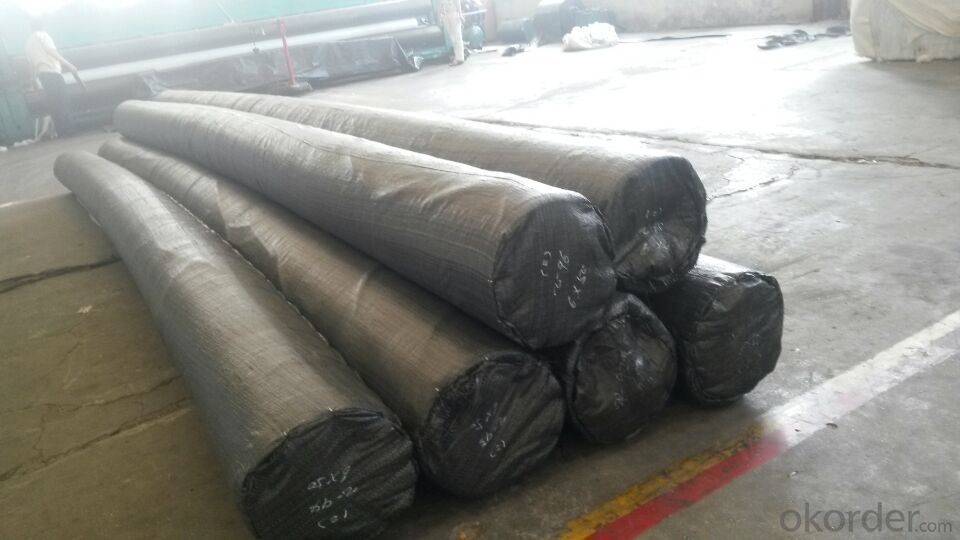
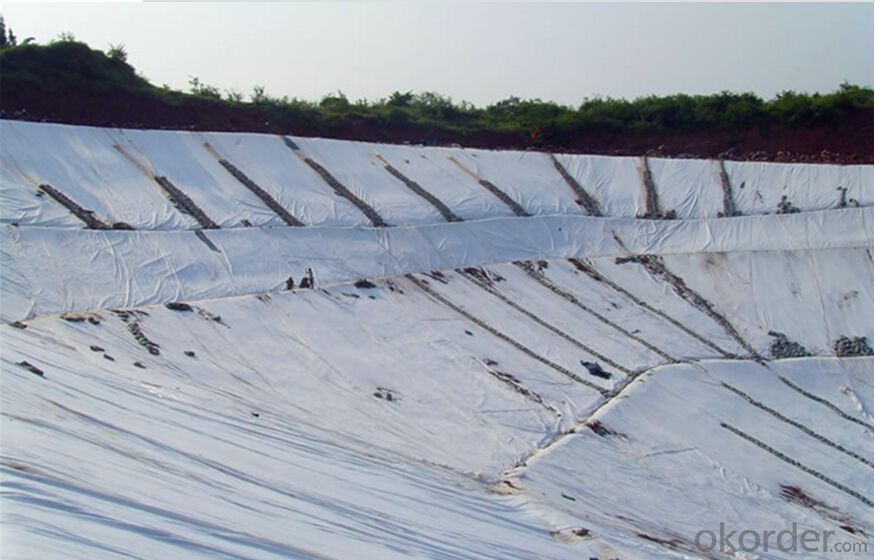


- Q:Can geotextiles be used for erosion control in coastal dunes?
- Yes, geotextiles can be used for erosion control in coastal dunes. Geotextiles are permeable fabrics that can be placed on the dune surface to help stabilize the sand and prevent erosion caused by wind and water. They can be an effective solution for protecting coastal dunes and preserving their natural ecosystem.
- Q:Unit of the quality of 400 geotextile piercing strong is generally how much? Hurry more
- First, geotextile polyester staple fiber geotextile (PET) and polyester filament geotextile two. Two kinds of geotextile anti-puncture strong (should be CBR burst strong) different. Polyester staple geotextile in accordance with the national standard GB / T-2008 standard implementation, 400g GB polyester staple geotextile CBR burst strength ≥ 2.1KN. Polyester filament geotextile in accordance with the national standard GB / T-2008 standard implementation, 400g GB polyester filament geotextile CBR burst strength ≥ 39KN. 400g GB polyester staple geotextile longitudinal and horizontal tear strength ≥ 0.33KN, 400g GB polyester filament geotextile longitudinal and horizontal tear strength ≥ 0.56KN.
- Q:How do geotextiles help with drainage?
- Geotextiles help with drainage by providing a filtration layer that prevents soil particles from clogging drainage systems, allowing water to flow freely while still retaining soil in place.
- Q:Do you have a drainage board and a geotextile on the basement roof?
- Hello, generally do not require re-test Huazhi geotextile materials, manufacturers need to answer for your needs
- Q:How do geotextiles contribute to the durability of civil engineering structures?
- Geotextiles contribute to the durability of civil engineering structures by providing reinforcement, filtration, and separation functions. They enhance the stability and strength of the structures by acting as a barrier, preventing the mixing of different soil layers and promoting proper drainage, which prevents erosion and reduces the risk of settlement. Additionally, geotextiles help distribute loads more evenly, reducing the potential for structural damage and extending the lifespan of the construction.
- Q:Can geotextiles be used for filtration purposes?
- Yes, geotextiles can be used for filtration purposes. They are permeable fabrics that can effectively filter out fine particles while allowing water or other fluids to pass through. This makes them suitable for applications such as erosion control, drainage systems, and preventing soil contamination.
- Q:How do geotextiles contribute to soil reinforcement in embankments?
- Geotextiles contribute to soil reinforcement in embankments by providing a stable and reinforced base for the soil. They act as a barrier, preventing soil erosion and maintaining the integrity of the embankment. The geotextiles distribute the load across a wider area, reducing the stress on the soil and preventing settlement. Additionally, they enhance the overall stability of the embankment by increasing its resistance to lateral forces and promoting better drainage.
- Q:How do geotextiles aid in the reduction of soil compaction?
- Geotextiles aid in the reduction of soil compaction by providing a barrier between the soil and external loads, distributing the load more evenly and reducing the pressure on the soil. This allows the soil to retain its natural structure and porosity, thereby minimizing compaction and preserving its ability to absorb and drain water effectively.
- Q:Design of interlocking turf slope protection brick directly on the geotextile, river earth side by 1: 2.5 slope excavation, began laying geotextile, grass sand and gravel, can lay it? Geotextile laying on the grassroots what are the requirements? More
- No special requirements, mainly from the role of filtering, over the water, but I, specializing in the production of geotextile, geomembrane, wish smooth
- Q:What are the different geotextile installation techniques in slope stabilization?
- Some of the different geotextile installation techniques in slope stabilization include anchoring the geotextile at the top and bottom of the slope, creating a reinforced soil slope with layers of geotextile and soil, and using geotextile wraps or sleeves to contain and reinforce specific areas of the slope. These techniques help prevent erosion, improve slope stability, and promote vegetation growth.
1. Manufacturer Overview |
|
|---|---|
| Location | |
| Year Established | |
| Annual Output Value | |
| Main Markets | |
| Company Certifications | |
2. Manufacturer Certificates |
|
|---|---|
| a) Certification Name | |
| Range | |
| Reference | |
| Validity Period | |
3. Manufacturer Capability |
|
|---|---|
| a)Trade Capacity | |
| Nearest Port | |
| Export Percentage | |
| No.of Employees in Trade Department | |
| Language Spoken: | |
| b)Factory Information | |
| Factory Size: | |
| No. of Production Lines | |
| Contract Manufacturing | |
| Product Price Range | |
Send your message to us
Geotextile Non Woven PP Earthwork for Road and Railway
- Loading Port:
- Tianjin
- Payment Terms:
- TT or LC
- Min Order Qty:
- 5000 m²
- Supply Capability:
- 2000000 m²/month
OKorder Service Pledge
OKorder Financial Service
Similar products
New products
Hot products
Hot Searches
Related keywords



